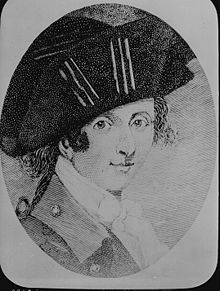Barry St. Leger
Barry St. Leger (often also St. Ledger ) (* 1737 ; † 1789 ) was a British officer. He fought during the French and Indian Wars in 1758 at Fort Louisbourg and in 1759 in the Battle of the Plains of Abraham and led an invading army during the American War of Independence in the course of the Saratoga campaign in 1777.
Life
St. Leger had Huguenot ancestors and studied at St. Peter's College of Cambridge University . On April 27, 1756 he began as an ensign in the 28th Infantry Regiment in the British Army and was transferred to America the following year. There he got to know the behavior of the Indians during the French and Indian Wars and gained a lot of experience in leading border wars. He served under General James Abercrombie in 1757 and took part in the siege of Louisbourg in 1758 . After accompanying James Wolfe to Québec , he took part in the Battle of the Plains of Abraham in 1759, where he watched the French flee. In July 1760 he became a brigade major , prepared for the march on Montréal and on August 16, 1762 major of the 95th Infantry Regiment.
In 1777 he was a lieutenant colonel in the 34th Infantry Regiment when he was on the recommendation of John Burgoynes by George III. was chosen to lead the western offensive that formed one arm of the Saratoga campaign . John Burgoyne promoted him to brigadier general for this mission with a certification , that is, without a pay increase, so that he was higher in rank than the militia generals involved . He moved his force in good order to Fort Stanwix , found it well defended, and began a siege. He repulsed an attempt by the American Militia to break the siege by ambushing Nicholas Herkimer's forces at the Battle of Oriskany . When (fake) rumors reached him about a strong relief force under Benedict Arnold , he was forced to withdraw to Canada.
literature
- St Leger, Barry . In: James Grant Wilson, John Fiske (Eds.): Appletons' Cyclopædia of American Biography . tape 5 : Pickering - Sumter . D. Appleton and Company, New York 1888, p. 371 (English, Textarchiv - Internet Archive ).
| personal data | |
|---|---|
| SURNAME | St. Leger, Barry |
| BRIEF DESCRIPTION | British officer |
| DATE OF BIRTH | 1737 |
| DATE OF DEATH | 1789 |
